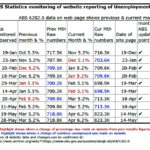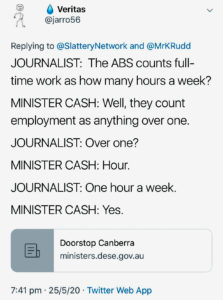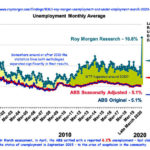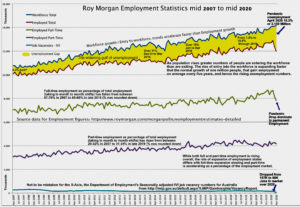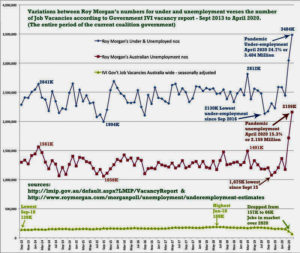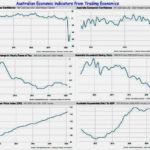Morrison announcement of “permanently increasing the rate of working-age payments by $50 a fortnight from 1 April 2021” received a lacklustre response. The Australian reporting about the lead-up to this said, “The base rate of JobSeeker is currently $570.80 a fortnight. But pressure has been mounting on the government to raise the rate with the $150 coronavirus supplement for welfare recipients ending in late March.”
Small bickies
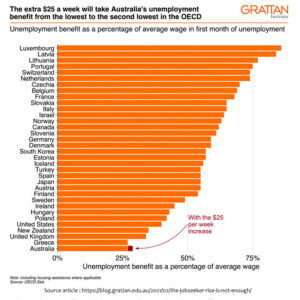
The Australian Council of Social Service’s disappointed response reported that they would have preferred $25 extra a day rather than a week. The cheapest coffee I can buy around in my suburb is $4, an extra $3.57 a day is hardly enough. It has, although, lifted our unemployment allowance from 37.5% to 41.2% of the national minimum wage. That means we will no longer have the lowest level of unemployment benefits as a percentage of the average salary in the OECD. Fifty dollars lifts us above Greece to second-last place. Mind you, the original Covid Jobseeker supplement incrementally lifted the unemployed for the first time, above the Henderson Poverty line.
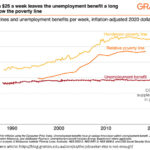
Paying such low levels “under the false pretence of encouraging more unemployed Australians to look for jobs” has no evidentiary basis. The international market demonstrates it has the opposite effect. Higher unemployment payments internationally are more often correlated with lower unemployment rates. More money flowing into Jobseeker generates spending in the economy, and drives demand. The multiplier effect of which, our country in recession has shown it desperately needs to boost the economy.
Training?
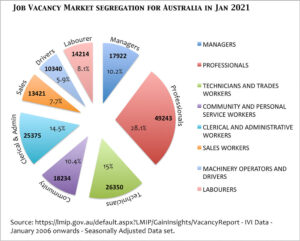
Despite the Coalition undercutting higher education, Michaelia Cash supported the idea that after six months on Job Seeker, recipients undergo training to help them get a job. Department of Employment figures show the smallest job market in January were the unskilled labourers (8.1%), Sales Workers (7.7%), Machinery Operators and Drivers (5.9%). This collection of low skilled jobs (37,975) are in rare supply in the Australian economy. Therefore, any Jobseeker training to elevate them to the skill level needed to widen their prospects would require extensive TAFE/University level education; well beyond “approved intensive short courses“.
Dob ’em in.
These were not the only changes Morrison implemented to job welfare. That Australian article also reported, “Under a raft of welfare reforms, Employment Minister Michaelia Cash said employers would be able to dob in unemployed Aussies who don’t take up jobs they are offered.” A move even Business groups denounced, let alone the welfare groups and unions. Social media references to “Dob a bludger!” accompanied curiosity as to the probability of emerging hotlines for “Dob in a wage thief” for businesses that were “accidentally underpaying workers“. Further suggestions provided ideas to establish hotlines for dob in a rorter, silencer of whistleblowers, white supremacist and sexual predators. It is tantamount to licensing abuse and employee exploitation which already occurs in industries like farming, retail and service.
Get off the couch!
The prevalent attitude towards the unemployed by politicians suggests that the unemployed are dominantly lazy, and distracted by Netflix as Nationals leader Michael McCormack claimed, or on drugs as our currently on leave, Attorney-General Christian Porter claimed when Social Services Minister. Several Federal ministers like David Littleproud MP, Senator Michaelia Cash, Senator Gerard Rennick, and Colin Boyce MP attacked the unemployed demanding they “get off the couch“, and get farmhand jobs that Australians discovered were not available. Others would suggest this patronising attack on people who, because of a recession and the pandemic, are without work, is merely targeting “low hanging fruit“. These Federal Ministers all would have us believe jobs are plentiful.
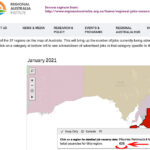
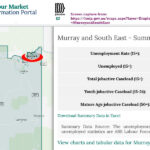
They are not alone in spouting propaganda that jobs are readily available. Minister for Families and Social Services Anne Ruston, in a Triple J Hack interview with Avani Dias on the 23rd of February, repeated the fallacious claim. That there are “plenty of jobs” in her region. This was demonstrably wrong. Based in Renmark, her territory in the Murray had 8,364 people on Jobsearch in Jan 2021 but only 626 job vacancies (13 times less than the people looking for work). That ratio is better than the national average (approx 18x), so perhaps she might have had something to boast about if she had only bothered to tell the truth.
What Jobs?
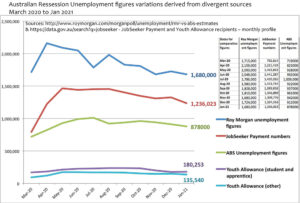
It isn’t easy to be finding a job in our economy, as reflected by any measure or methodology:
– jobs claimed by ABS (254,400 jobs), Dept of Employment (175,100 jobs), Seek (182793 jobs);
verses
– the unemployed registered by Jobseeker (1.236M people), ABS (877,600 people) or Roy Morgan (1.68M people). {All Stats currently published as of the end of Feb 2021 for January 2021}
These measures demonstrate that irrespective of what stats you accept, there are far more unemployed than available jobs. Beyond understanding the basics of how unemployment is measured, it is crucial to understand what some methodologies do not appraise.
The difference between ABS and Roy Morgan’s stats are considerable, and while the government and Main-Stream Media lean heavily on the ABS measure, we should appreciate what it represents. I have for a long time explained the ABS’s shortcomings from it’s
- exclusions of anyone doing any work in a month,
- exclusions for unpaid work in a family business,
- exclusions of foreign workers through 12/16 rule,
- hiding the increasing gig / part-time economy,
- exclusions of persons unable to take up immediate work,
- hiding unemployment via the government PaTH program.
Subsets
These exclusions mean that what the ABS measures is not our internal domestic unemployment, but a subset of the numbers of unemployed for reasons of international comparison. A long time economic analyser of ABS statistics, Alan Austin, expressed similar conclusions, to that of my recent article on this subject.
To be clear, ABS measures a subset of our internal unemployment, as are JobSeeker numbers. The disparity between them illustrated in the variations graph depicts the entire period over which Job Seeker has existed. ABS’s subset, guided by the ILO methodology, facilitates international comparison, but does not measure any country’s national unemployment numbers. These stand in stark contrast to Murdoch and Nine Media’s claims that unemployment is a single whole digit percentage rate. Roy Morgan reveals unemployment hasn’t been under 10% since February 2020, and neither has under and unemployment been under 20%.
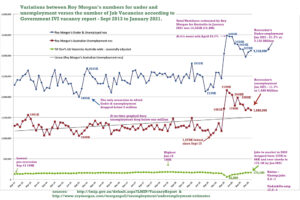
So ABS’s claimed 877,600 unemployment numbers are a subset of the domestic reality. Similarily ABS claimed a 2.08 million subset of under and unemployed. Alan Austin and I are in enthusiastic agreement that “It might be time for the unemployment rate published by Australia’s Bureau of Statistics (ABS) to be put out to pasture.” Alan continued affirming “the steam engine that is Roy Morgan’s real unemployment rate”. Roy Morgan shows in January 2021, unemployment is 1.68 million people, and adding underemployment reaches 3.118 million souls looking for a decent job. The Department of Employment’s IVI job vacancy report for January reveals that over three million people in Australia are competing for 175,100 jobs. Nearly 18 people for every job advertised, and we are not even beginning to deal with the logistic issues of job searching.
Location, location, location.
Beyond Australia’s 19 cities, over 100K population, there are 1700 towns with populations between that and a thousand people. Spreading 175,100 jobs across a continent representing 5% of the earth’s landmass, when the towns are dominantly coastal, represents the first challenge to job seekers. An “off the back of an envelope” averaging for any given town/city would tell you that more than 100 jobs in a given population centre mean you are probably living in a city. Which might mean less than ten jobs advertised in that region will be for unskilled labour (8.1%). That’s not a nuanced presumption, as industry and commercial activity vary considerably from place to place, and I’ve given no consideration to rural areas. Still, one might understand that job locality has to be one of the most considerable obstacles for the unemployed.
The government’s expectation announced on the 23rd of February is “job seekers will be required to search for a minimum of 15 jobs a month from early April, increasing to 20 jobs per month from the 1st of July“. Purely considering the subset of the unemployed on Jobseeker (1.236M people) generating 15 applications per month creates 18 million letters and has the potential to cover every advertised job in Australia 105 times until July, when it will be 141 times. Given the likelihood of the number of jobs existing in your city or town as aforementioned, just how long will it take any given unemployed person to run out local employers?
Limitations to employment are locality and factors such as job requirements for education and/or skills, competition for work, financial limitations/burdens, physical/mental impediments, security clearances, pay awards not commensurate with needs and employment discrimination and/or exploitation.
Nobody in the coalition government is prepared to concede they are failing the unemployed. The party of “Jobs and Growth” has in reality been expanding “Unemployment and Recession” for years and no policy the government has implemented in Morrison’s $9B Social Security Safety Net seems capable of changing that path.
